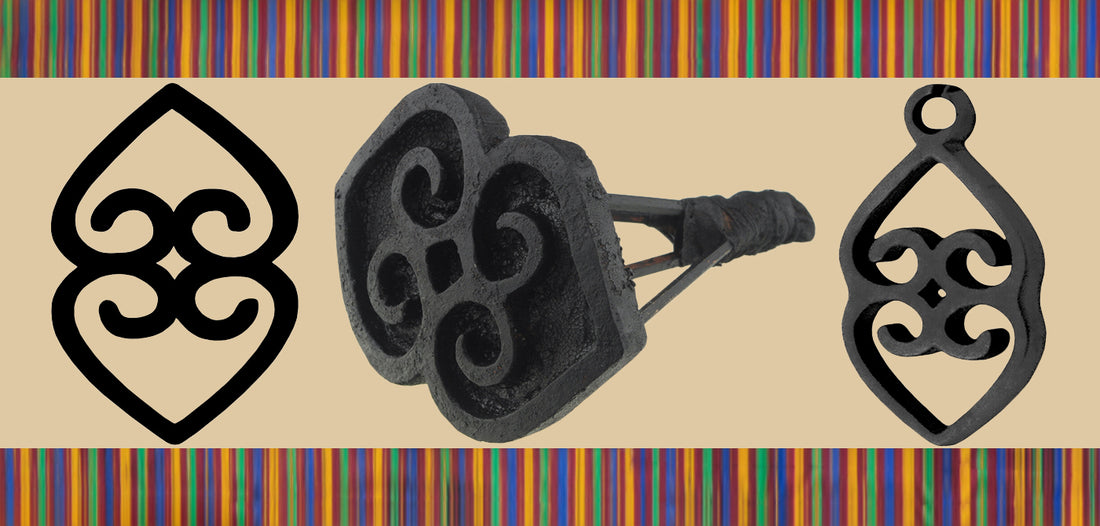
The Significance of Asase Ye Duru: Exploring the Depth of Adinkra Symbols
Share
The Meaning and Significance of Asase Ye Duru: A Symbol of Mother Earth's Divinity
In the rich tapestry of Akan culture, the Adinkra symbols serve as visual representations of proverbs, wisdom, and cultural values. One of the most profound and spiritually significant of these symbols is Asase Ye Duru, which translates to "The Earth has weight" or "The Earth is heavy." This symbol reflects the Akan people's deep respect for the Earth, viewing it not only as a physical entity but as a spiritual force of life and sustenance.
Asase Ye Duru is a reminder of the central role that Mother Earth plays in providing sustenance, life, and shelter. It embodies the concept of reverence for nature, the nurturing power of the Earth, and the need to honor and protect the environment. This article explores the origins, meaning, and cultural context of Asase Ye Duru, as well as its relevance in modern times.

Origins of the Symbol Asase Ye Duru
The Adinkra symbols, including Asase Ye Duru, are deeply embedded in Akan culture, particularly among the Ashanti people of Ghana. According to oral tradition, Adinkra symbols were originally created by the Ashanti and the neighboring Gyaman people (in present-day Côte d'Ivoire). The symbols have been used for centuries to communicate messages of wisdom, history, and values through art, textiles, and everyday objects.
The creation of Adinkra symbols is believed to have been influenced by both historical events and the Akan people's strong connection to their environment. Asase Ye Duru, in particular, reflects the Akan's philosophy that the Earth is not merely a resource to be exploited but a sacred entity that bears life, nurtures growth, and sustains communities.

The Cultural and Spiritual Significance of Asase Ye Duru
The symbol Asase Ye Duru represents the weight and importance of the Earth. In Akan cosmology, the Earth (Asase) is considered a mother figure—Asase Yaa, or Mother Earth, who nurtures all living beings. The Earth is revered not just for its material wealth (such as crops and minerals) but for its spiritual significance. It is believed that the Earth holds the spirits of ancestors and serves as a conduit for human relationships with the divine.
This symbolism extends beyond material wealth to the understanding that the Earth must be respected and treated with care. The Akan believe that to harm the Earth is to harm the source of life itself, which is why Asase Ye Duru also implies a moral responsibility to protect the environment. This respect is reflected in traditional Akan practices, such as land use and agricultural methods that emphasize sustainability and communal harmony.
Proverbs and Interpretations Related to Asase Ye Duru
Several Akan proverbs echo the sentiments represented by Asase Ye Duru, reinforcing its message of respect and responsibility:
-
“Asase ye duru, gyae n'anim, gyae no.”
Translation: "The Earth is heavy, stop and respect it."
This proverb emphasizes the need to recognize the significance and weight of Mother Earth, urging humans to be mindful and respectful of nature and the environment. -
“Asase ye duru sen gya.”
Translation: "The Earth is heavier than fire."
This highlights the enduring power and importance of the Earth, suggesting that the Earth’s significance and sustenance outweigh the destructive forces of fire, symbolizing the permanence and resilience of nature. -
“Asase bɔne yɛ bɔne, nso ɛwɔ ne ho adeɛ.”
Translation: "Even bad land has something of value."
This proverb reflects the idea that all parts of the Earth have worth and value, encouraging people not to overlook or undervalue any piece of land, no matter how difficult it may seem. -
“Asase so yɛ tɛn wɔ wura so.”
Translation: "A fertile land depends on the one who owns it."
This speaks to the responsibility of those who control land to care for it, ensuring its productivity and sustainability.
Modern Usage and Representation of Asase Ye Duru
In contemporary Ghanaian society, the symbol Asase Ye Duru continues to be a prominent feature in visual art, textiles, and cultural expressions. Traditionally, Adinkra cloths adorned with this symbol were worn during significant events, particularly funerals, to honor the deceased and acknowledge the weight of life and death. Today, the symbol has expanded beyond funerary contexts and is commonly found in fashion, jewelry, architecture, and home décor as a reminder of environmental stewardship and respect for nature.
Furthermore, Asase Ye Duru has gained international recognition through the popularity of Adinkra symbols in modern design. Artists and designers incorporate the symbol into their work to evoke themes of environmental consciousness, sustainability, and cultural heritage.

The Relevance of Asase Ye Duru in Environmental Conservation
As the world faces increasing environmental challenges, the message of Asase Ye Duru is more relevant than ever. The idea that the Earth is heavy and deserving of respect aligns with modern concepts of sustainability and environmental conservation. The Akan belief in the sanctity of the Earth serves as a powerful reminder of humanity's duty to protect natural resources and honor the balance of ecosystems.
Incorporating Asase Ye Duru into contemporary discourse on the environment highlights the importance of traditional wisdom in addressing global issues such as climate change, deforestation, and pollution. By embracing the values of this symbol, societies around the world can work towards a future that respects and preserves the Earth's natural resources.
Conclusion
Asase Ye Duru is more than just a symbol—it is a representation of the profound respect that the Akan people have for the Earth and the environment. This Adinkra symbol conveys a powerful message about the weight and significance of nature in both the spiritual and physical realms. As the world grapples with environmental degradation, the wisdom of Asase Ye Duru offers timeless lessons on the need for sustainable living, environmental responsibility, and respect for the planet.


